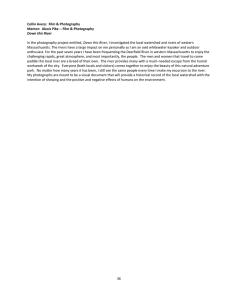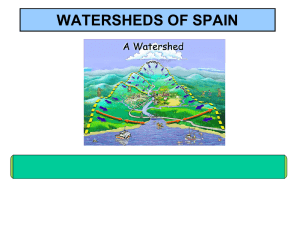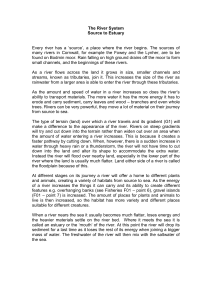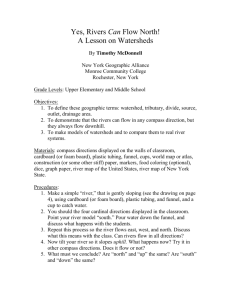The Columbia River Watershed: Notes on a Pastoral Letter Emerging
advertisement
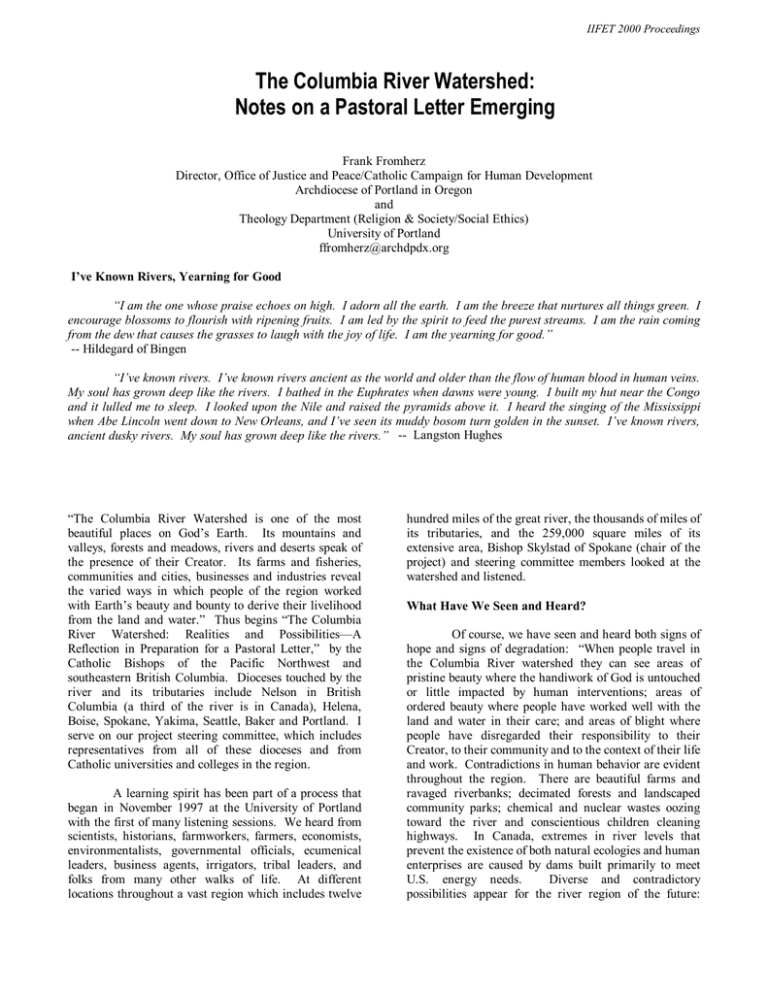
IIFET 2000 Proceedings The Columbia River Watershed: Notes on a Pastoral Letter Emerging Frank Fromherz Director, Office of Justice and Peace/Catholic Campaign for Human Development Archdiocese of Portland in Oregon and Theology Department (Religion & Society/Social Ethics) University of Portland ffromherz@archdpdx.org I’ve Known Rivers, Yearning for Good “I am the one whose praise echoes on high. I adorn all the earth. I am the breeze that nurtures all things green. I encourage blossoms to flourish with ripening fruits. I am led by the spirit to feed the purest streams. I am the rain coming from the dew that causes the grasses to laugh with the joy of life. I am the yearning for good.” -- Hildegard of Bingen “I’ve known rivers. I’ve known rivers ancient as the world and older than the flow of human blood in human veins. My soul has grown deep like the rivers. I bathed in the Euphrates when dawns were young. I built my hut near the Congo and it lulled me to sleep. I looked upon the Nile and raised the pyramids above it. I heard the singing of the Mississippi when Abe Lincoln went down to New Orleans, and I’ve seen its muddy bosom turn golden in the sunset. I’ve known rivers, ancient dusky rivers. My soul has grown deep like the rivers.” -- Langston Hughes “The Columbia River Watershed is one of the most beautiful places on God’s Earth. Its mountains and valleys, forests and meadows, rivers and deserts speak of the presence of their Creator. Its farms and fisheries, communities and cities, businesses and industries reveal the varied ways in which people of the region worked with Earth’s beauty and bounty to derive their livelihood from the land and water.” Thus begins “The Columbia River Watershed: Realities and Possibilities—A Reflection in Preparation for a Pastoral Letter,” by the Catholic Bishops of the Pacific Northwest and southeastern British Columbia. Dioceses touched by the river and its tributaries include Nelson in British Columbia (a third of the river is in Canada), Helena, Boise, Spokane, Yakima, Seattle, Baker and Portland. I serve on our project steering committee, which includes representatives from all of these dioceses and from Catholic universities and colleges in the region. A learning spirit has been part of a process that began in November 1997 at the University of Portland with the first of many listening sessions. We heard from scientists, historians, farmworkers, farmers, economists, environmentalists, governmental officials, ecumenical leaders, business agents, irrigators, tribal leaders, and folks from many other walks of life. At different locations throughout a vast region which includes twelve hundred miles of the great river, the thousands of miles of its tributaries, and the 259,000 square miles of its extensive area, Bishop Skylstad of Spokane (chair of the project) and steering committee members looked at the watershed and listened. What Have We Seen and Heard? Of course, we have seen and heard both signs of hope and signs of degradation: “When people travel in the Columbia River watershed they can see areas of pristine beauty where the handiwork of God is untouched or little impacted by human interventions; areas of ordered beauty where people have worked well with the land and water in their care; and areas of blight where people have disregarded their responsibility to their Creator, to their community and to the context of their life and work. Contradictions in human behavior are evident throughout the region. There are beautiful farms and ravaged riverbanks; decimated forests and landscaped community parks; chemical and nuclear wastes oozing toward the river and conscientious children cleaning highways. In Canada, extremes in river levels that prevent the existence of both natural ecologies and human enterprises are caused by dams built primarily to meet U.S. energy needs. Diverse and contradictory possibilities appear for the river region of the future: IIFET 2000 Proceedings economic stability and ecological integrity and sustainability if people take seriously their responsibilities for God’s earth; ecological disaster and economic depression if current practices remain unchanged.” Memory and Vision The letter invites all people of good will to reflect more deeply on their common spirituality and on how connected their history is with the rivers and watersheds. How have rivers and watersheds been present in your story? The first few years of my life were spent in an old house on an acre of ground in Northeast Salem. I remember being down by the riverside for family picnics and watermelon parties, down by the Willamette that runs through Oregon’s capital. During my grade school years our family lived on a small berry farm near Silverton. Scism Creek runs through the place. Just before I entered high school we sold the berry farm and moved to a dairy about ten miles up river from the mouth of the Big Nestucca. What are those formative places you can recall? My sons and I went with my dad a few years ago to see the place on Kiger Island, just south of Corvallis, where dad lived as a child. The Willamette flooded one time when Dad was only five and it got so bad they left the island and moved to a hilltop place close to Lebanon. Dad remembers that his father homesteaded as a logger along the Alsea River up from Waldport, early in the century. On my mother’s side of the family, the mouth of the Yachats River could be viewed from the simple home of my seascape artist “Gramps” and musicloving Grandmother. Today I live near the confluence of the Willamette and Columbia Rivers. Degradation shows up through industrial pollution, salmon endangerment and extinction, consolidation of ownership of land and commercial enterprises into fewer individual and corporate hands, political manipulation by some, habitat destruction by habits of nearly all of us. Yet hope springs up here and there: “Many people responsibly live from and work with the gifts of the Columbia and its tributaries. Many people are conscious of their own and others’ actions that have brought harm, and are striving to promote traditional values, teach objective scientific data, guide human activities, and shape corporate operations and community consciousness in ways that will benefit the watershed and thus, ultimately, all who depend on it for their lives and livelihood.” Many community development organizations, agricultural and forestry operations, government agencies, and businesses in rural and urban communities account for a triple bottom line: economy, ecology and social equity. More and more companies are taking the “natural step,” showing that sustainable business can honor ecosystem health and support social and economic benefits to surrounding communities. Our pastoral reflection includes “The Rivers of our Moment,” analyzing the present situation of the watersheds, “The Rivers through our Memory,” reflecting on social and religious history, “The Rivers in our Vision,” imagining an alternative future for the watersheds, and “The Rivers as our Responsibility,” calling for action to make the vision a new reality. Bishop Skylstad of Spokane has a vivid sense of place: “How blessed are we here in the Northwest to have the mighty Columbia River and its tributaries. One of the great blessings of my own life is to have grown up on the river, not directly on the Columbia but 15 miles from it on one of its tributaries, the Methow. As a child and youth, I remember the constant roaring of the rapidly flowing river as the waters made their way to the sea. For us as a family on the river, the water was used not only for drinking but provided irrigation for an apple orchard and an alfalfa field. The river in those days contained a bountiful supply of many varieties of fish. In the summer and early fall, the salmon swam upstream to their spawning grounds, to exactly the same gravel bar from which they were hatched. We could climb on the high bank or on a bridge to catch sight of ‘the big one,’ marveling that four years before they would have headed out to sea as fingerlings and return sometimes as 30 or 40 pound fish…. As a young boy, I remember looking at the river and wondering where that water was going, where it would end up. There was a quality about its connectedness that I recognized even then…. As we reflect on this sense of connectedness of the river, we are filled with a sense of awe and appreciation of this wonderful gift and treasure in our midst, the flowing waters of life.” From the outset the project goals have been fivefold: 1) to invite the Catholic community and all people of good will to reflect more deeply on their common spirituality and on how connected their history is with the rivers; 2) to highlight the key ethical dimensions arising from an application of Catholic social teaching to the environmental, social, economic, cultural and political issues surrounding the watersheds; 3) to express the church’s concern for all the women, men and children whose lives are directly impacted by the Columbia River economy and related ecological problems; 4) to initiate a broader discussion on the potential contribution of faith communities in the Pacific Northwest and British Columbia to common action that will help sustain and renew the watersheds and a commitment to the common good; and 5) to promote a vision of a just and sustainable way for the people of the watershed region to relate to the rivers. I want to focus on two of these, the rivers of our memory and the rivers (or, more widely, the watersheds) of our vision. 2 IIFET 2000 Proceedings Taking stock of one’s place—one’s community of memory—by the rivers (a mountain, desert, coast, whatever the precise and wondrous geography prominent in our stories) can shed light on this deep connectedness. blessed corner of that universe, gifted with unique natural blessings, is humanity’s home, and humans are never so much at home as when God dwells with them….Throughout history, people have continued to meet the Creator on mountaintops, in vast deserts, and alongside waterfalls and gently flowing springs….We still share, though dimly, in that sense of God’s presence in nature. But as heirs and victims of the industrial revolution, students of science and the beneficiaries of technology, urban-dwellers and jet-commuters, (we) have grown estranged from the natural scale and rhythms of life on earth….The Christian vision of a sacramental universe – a world that discloses the Creator’s presence by visible and tangible signs – can contribute to making the earth a home for the human family once again. Pope John Paul II has called for Christians to respect and protect the environment, so that through nature people can ‘contemplate the mystery of the greatness and love of God.’….Dwelling in the presence of God, we begin to experience ourselves as part of creation, as stewards within it, not separate from it.” Every region has a larger story to tell. We can bring our stories together, like tributaries feeding a larger water. Could we who live in the Pacific Northwest relate wisely to our places—our commons? Our commons is made of mountains, peaks, rivers, valleys, the Gorge, rain forests, creatures of great variety, tenacity, fragility, character, and ferns, moss, sage, deserts, high plains, and hot, cold, bone dry, almost ontologically wet, extreme and temperate. Could we know how to cherish, restore and sustain the common good among us? We can experience place with deep reverence. It is not impossible for us to live a way of life tuned to the symphony of the seasons and guided by nature’s orchestral compositions. What steps can we take to shape a vision of a just and sustainable way for the Catholic community and all people of good will to relate to the rivers and watersheds of our region? Our reflection offers vision questions that might challenge all of us to reflect on our stories: “As a watershed people, we must analyze our regional situation and ask ourselves, What might the Columbia River watershed look like if it were regarded and treated as a sacramental commons, a shared ecoystem revealing God to us? Will future generations of children be able to fish successfully and swim joyfully as we did decades ago in favorite places? Will we have communities of neighbors considerate of each others’ needs? Will farmers and fishers, loggers and outfitters, workers and entrepreneurs find mutual respect and share equitably in the bounty of the watershed? Will we be able to roam prayerfully again through forest groves whose silence is broken not by the roar of an engine but by the joyful song of a bird or the breath of the wind weaving through branches and whispering leaves? Will the diversity of life be respected in a new ecological consciousness and with a new conscientious attitude of care for the needs of all creation, living and nonliving? If we are concerned about the conditions that prompted these questions, then we should become involved in efforts to transform the Columbia watershed.” Bishops and pontiffs are not the only voices reflecting on rivers and creation. Many other voices, with profound memories, have been gathered in “The Tribal Vision for the Future of the Columbia River Basin,” by the Columbia River Inter-Tribal Fish Commission. This body represents the Umatilla, Warm Springs, Yakama and Nez Perce Tribes. “The tribal vision for the future is one where all watersheds – from the smallest tributary to the basin as a whole – are once again regarded with respect and reverence for what they truly and inescapably are – home. It is a vision in which we once again return to the notion that we must nurture and sustain our home as it nurtures and sustains us.” The tribal vision asks us to remember that we participate—as human beings—in the relational way of the rest of the universe. The Catholic ethic of care for creation has much to learn here. Too often we think primarily about how we can care for the earth, how we can be its stewards, and forget how we depend on the earth. As the tribal vision says, our home nurtures and sustains us. This is the mutuality and reciprocity we need to humbly acknowledge. Reciprocity is at work in the natural economy. The marine ecologist Jane Lubchenco writes: “Think now about how you depend on nature. Most folks will focus on the goods that we get from nature: food, fiber, genes, medicine. Most of us are unaware of the services that are provided to us by the ecological systems of the planet…. These are all services that are provided by different ecological systems—forests, grasslands, deserts, wetlands, coral reefs, kelp forests, estuaries…. Decisions about how to use land, how to use water, how to use resources are based primarily on a consideration of the relative costs and benefits of the goods, not of the services…. As water moves through watersheds, the microbial action in the soils provides a very important It might be wise for me to shed a little more light on the mystery, what we mean by “the sacramental commons.” No property is absolutely private property. It is not the doctrine of private property that is sacred; it is the land itself that is sacred. All is part of the commons we share with one another and all creatures. Indeed, this sacramental commons—our Columbia & tributaries region—is part of a greater commons, a sacramental universe. In “Renewing the Earth,” a pastoral statement of the US Bishops (1991), we hear that: “The whole universe is God’s dwelling. Earth, a very small, uniquely 3 IIFET 2000 Proceedings service of detoxifying or sequestering pollutants.” She points to the example of the Catskill watershed—how the city of New York decided to let the natural economy of the watershed provide the service, by a decision to restore that watershed rather than invest much greater capital in a water purification/filtration plant. Well of course, it is not a new way; it is a very ancient way, deeply tied to the sense of home so well expressed in the tribal vision statement. We are cared for by creation, in very pragmatic ways. And there is another level of reciprocity that is deeper even than this notion of mutual service and care. We might come to view reciprocity at a level beyond our caring for earth and earth caring for us. At a deeper level creation can do much more than serve us, all of creation can teach us. The rivers and watersheds are our teachers and mentors, not only our servers and caretakers. The profound memories that guide the brush strokes of the tribal vision suggest a reverent sense of place, listening, learning, remembering. By honestly remembering (not just our recollections of communing with place, but also our habits of degradation) we might gradually live into a more sustainable way of life. To truly enter into the heart of a place, we will have to view the great Columbia and its tributaries as a living story. We can be embraced by an intensity of meaning—as many levels of story converge— beckoning us home. My dearest Bridget has helped me to begin to understand the implications of recovering the wisdom of the rivers and watersheds--a spirituality fed by reciprocity. Our true home, Mother Earth, is a great teacher of reciprocity. And so it is with the watersheds. that finally led to an impasse in our relations with the natural world. Our commercial-industrial obsessions have disturbed the biosystems of this continent in a depth never known previously in the historical course of human affairs.” Berry asks us to restore our continuity with creation. “The deepest cause of the present devastation is found in a mode of consciousness that has established a radical discontinuity between the human and other modes of being…. In this context the other than human becomes totally vulnerable to exploitation by the human, an attitude that is shared by all four of the fundamental establishments that control the human realm: governments, corporations, universities, and religions— the political, economic, intellectual, and religious establishments…. In reality there is a single integral community of the Earth that includes all its component members whether human or other than human. In this community every being has its own role to fulfill, its own dignity, its inner spontaneity. Every being has its own voice….Every being enters into communion with other beings. This capacity for relatedness, of presence to other beings, for spontaneity in action is a capacity possessed by every mode of being throughout the entire universe….Perhaps the most valuable heritage we can provide for future generations is some sense of the Great Work that is before them of moving the human project from its devastating exploitation to benign presence….We cannot doubt that we too have been given the intellectual vision, the spiritual insights and even the physical resources we need for carrying out the transition that is demanded of these times, transition from the period when humans were a disruptive force on the planet Earth to the period when humans become present to the planet in a manner that is mutually enhancing.” Like places alive with history and hope all across the globe, these rivers and watersheds connect and teach us about reciprocity. The Columbia crosses international and state boundaries, reminding us that the common good transcends political boundaries. Tributaries and unseen groundwater underscore how the common good is fed by diverse sources too often unrecognized. We hope our religious perspective can be in dialogue with folks from across many traditions and worldviews, and we recognize that many insights about a healthy ecology and sustainable economy have been lifted up by wise voices in realms outside organized religion. We indeed, as one faith tradition, have so very much to learn from other communities of memory and hope. We are beginning to listen. We have so much to learn. Concern about creation can help us read our own sacred texts in a new—or very old but forgotten—light. The letter, itself an invitational “work in process,” will be shared with the public soon. There are indeed many “sacred books.” We are part of a book we must read with awe, care, memory, and vision—the book of nature written in the intricate web of relations that form the stunning beauty and humbling fragility of our watersheds. If we are to begin to see the rivers and watersheds and all of creation as living story, or even more profoundly, as mentors and story-tellers, we will have to be honest about our dubious history. In a new book, entitled “The Great Work,” Thomas Berry writes: “Here in North America it is with a poignant feeling and foreboding concerning the future that we begin to realize that the European occupation of this continent, however admirable its intentions, has been flawed from the beginning with its assault on the indigenous peoples and its plundering of the land….New achievements in science, technology, industry, commerce and finance had indeed brought the human community into a new age. Yet those who brought this new historical period into being saw only the bright side of these achievements. They had little comprehension of the devastation they were causing on this continent and throughout the planet, a devastation 4 IIFET 2000 Proceedings References – Selected Poems of Langston Hughes, Vintage Classic edition, 1990. “The Columbia River Watershed: Realities and Possibilities – A Reflection in Preparation for a Pastoral Letter,” (see our website www.columbiariver.org), 1999. For more information about Sustainable Northwest and efforts to honor people, businesses and communities through its Founders of a New Northwest program, see sustnw@teleport.com. I have written more extensively about story and place in “A Sense of Place,” a chapter in All Creation Is Groaning: An Interdisciplinary Vision for Life in a Sacred Universe, eds., Carol Dempsey and Russell Butkus, Liturgical Press, 1999. Bishop Skylstad shared his story, “The Columbia— Flowing Waters of Life: Gift and Treasure,” as the presenter at our 1998 Tobin Lecture in Portland. “The Tribal Vision for the Future of the Columbia River Basin, and How to Achieve It,” Columbia River InterTribal Fish Commission (see www.critfc.org), 1999. See “Earth’s Unruly Tenant,” by Jane Lubchenco, in Open Spaces, volume 2, issue 1, 1999. For background on Catholic theology, social ethics, and key documents within official Catholic teaching that have set the stage for the pastoral letter on the watersheds, please see “And God Saw That It Was Good” – Catholic Theology and the Environment, eds., Drew Christiansen and Walt Grazer, United States Catholic Conference, 1996. Thomas Berry, The Great Work: Our Way Into The Future, Bell Tower, 1999. About the Author -- Frank Fromherz, Ph.D., is director of the Office of Justice and Peace/Catholic Campaign for Human Development, Archdiocese of Portland in Oregon. He is also adjunct faculty member (Religion & Society/Social Ethics) in the theology department, the University of Portland. He can be reached at ffromherz@archdpdx.org. 5
